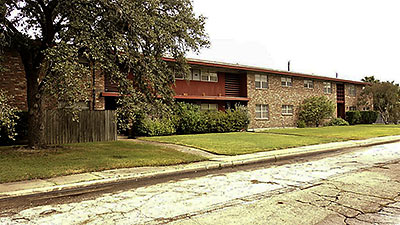
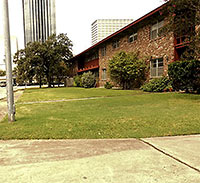 Here’s a prediction from a reader about the fate of these apartments just inside the Loop at 4724 Oakshire Dr.: “It looks like another older apt. complex in/near Afton Oaks will probably soon be no more. At least, the building is being sold and all the residents just got a 45 day notice to move out (I don’t know for sure they’re tearing it down, but the odds are it will be). It’s a pity, because it’s a very well-made building (and, from what I’ve seen of some of the construction going up in the area, that’s not the case for a lot of the newer buildings).”
Here’s a prediction from a reader about the fate of these apartments just inside the Loop at 4724 Oakshire Dr.: “It looks like another older apt. complex in/near Afton Oaks will probably soon be no more. At least, the building is being sold and all the residents just got a 45 day notice to move out (I don’t know for sure they’re tearing it down, but the odds are it will be). It’s a pity, because it’s a very well-made building (and, from what I’ve seen of some of the construction going up in the area, that’s not the case for a lot of the newer buildings).”
***
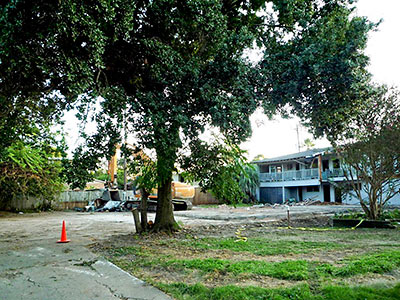
The 12-unit building is just across Oakshire from where the baby blue 8-plex shown in the photo directly above came down this past September.
The reader continues:
[The owner of 4724 Oakshire] was living here and managing it himself for many years, but he’s in his 70s and I . . . imagin[e] he’s just finally ready to retire. . . . The real estate announcement that was posted seemed to be encouraging people who wanted to keep and upgrade the property, but they seem to be just tearing everything down in that area . . . .
The listing the reader refers to says a sale of the 10,106-sq.-ft. building that dates to 1955 is pending. Calls to the agent for more information haven’t been returned.
- 4724 Oakshire Dr. 77027 [Gary Greene]
- Previously on Swamplot: Clearing an “Almost Afton Oaks†8-Plex’s Troubled Twin
Photos: Gary Greene (4724 Oakshire); Jared Meadors (4725 Oakshire)


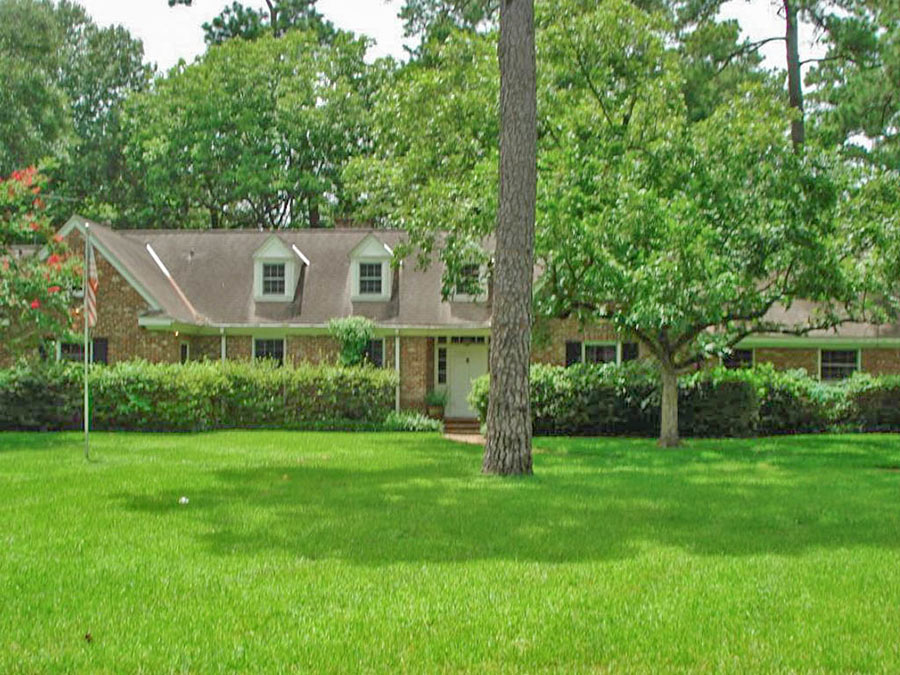

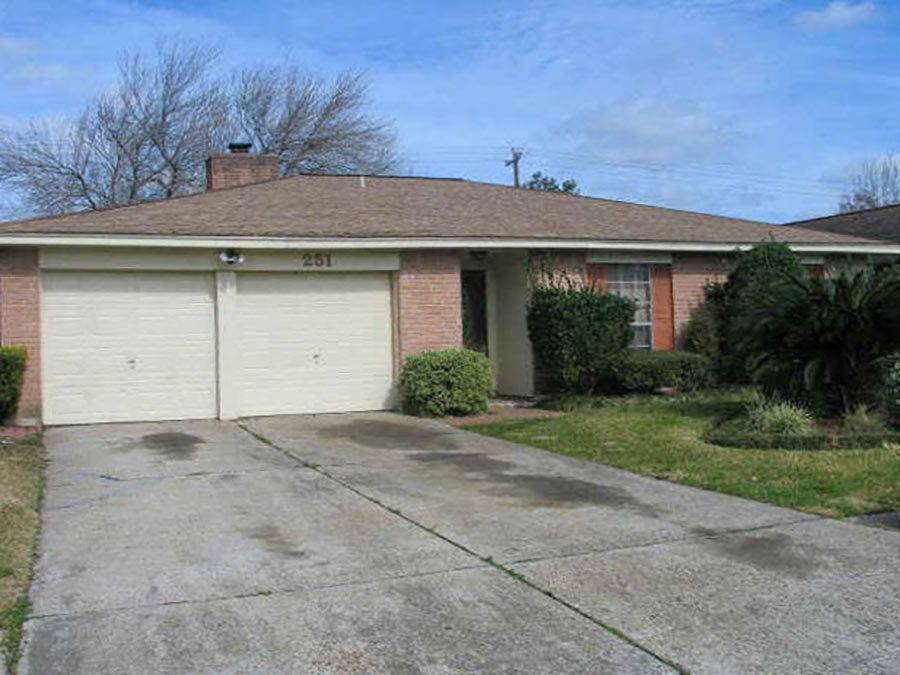
“…It’s a pity, because it’s a very well-made building (and, from what I’ve seen of some of the construction going up in the area, that’s not the case for a lot of the newer buildings)…”
What a bunch of crock, unless you’re intimately familiar with construction processes and techniques you can’t gauge the quality of construction by “looks of it”. Additionally all new construction is heavily engineered and thoroughly inspected, so that notion is complete fallacy. Unless the Old building was built entirely of masonry and properly maintained, the new construction will Always be structurally better than old.
If you have an old building that’s still standing with fe cracks and good plumbing and electrical, then yeah, I think you can make an educated guess about the condition of the building.
There is a well-known formula for determining the dollar value that the quality of the construction adds to the subject property.
V = P × A × 1M
Where V is the final value, P is the current market price/square foot of land, A is the surface area of the property in ft2, and M represents the quality of the original construction on a scale of 1 to 100.
Hmm. That formula doesn’t seem to work.
THE LOCATION OF THIS PROPERTY MAKES IT A CERTIFIED DUMP.
Nothing special about that old place. Looks like it was kept up better than most places its age, but if that thing were down Hillcroft it would be half burned out, and half abandonned. Tear down for sure.
Bill, I got the formula to work. Seems dead on, to me.
@mek ju – A very interesting and arbitrary formula, this is a new one on me. Is there some tried and true formula that determines M? After 25 years of buying/selling investment properties, the greatest determining factor for redevelopment has always been when the land costs exceed the income approach, the property is re-developed so that the land cost is then supported.
GLENW WHAT ARE YOU EVEN REMOTELY TRYING TO SAY ABOUT HILLCROFT?
It’s a shame Houston has no respect for older nice affordable apartments on inner loop Westside. I lived at The Creole on Yorktown when I first got out of Texas and I loved it! I’ve been waiting to hear that it’s meet the wrecking ball, though I always understood that Mr. Finger had a special feeling about The Creole. Time will tell. Also, who cares about Hillcroft, what does Afton Oaks remotly have in common with that area. Talk about Apples and Oranges…get real
I don’t see why Houston has to have “respect” for old cheap apartments in the west inner loop. If market value dictates redevelopment, then so be it. There are plenty of affordable apartment in the Gulfton / Sharpstown area just a mile or two away. Not mention the entire east side of the inner loop and most areas just outside the loop apart from the Tanglewood / Memorial corridor.
HOUSLandMan, I figured it out. Yesterday it didn’t show 1 to the Mth power, just 1M which I assumed was a typo. Nice back-of-the-cocktail-napkin formula.
The formula cannot possibly work.
.
The final term is 1 raised to somewhere between the first and the 100th power. Whatever the exponent is, the final value of that term is 1. So regardless of the construction quality value you use, the equation becomes V = P × A .
.
Unless that was the point you were trying to make?
These were the “nicest” of the group tenements on Vossdale. I can only hope the others meet a similar fate.
“Unless that was the point you were trying to make?”
touche.
Nice formula.
Phil gets it.
For me, as someone who routinely buys, restores, and holds these types of property for the long term (including a property right across the street from this one that is roughly the same age / type of construction), the only thing that I consider when determining value (and this a pretty standard / typical metric) is CAP rate.
Specifically, I use the CAP rate at current rents and expenses to determine what it is worth today… and I calculate a projected CAP rate after renovations to determine what it will be worth with higher rents.
The CAP rate is just a simple calculation for the rate of return on your cash in the deal. If you are simply buying a property and continuing on as is, the CAP rate is the return (from cashflow) on your down payment. If you are planning to upgrade the property the CAP rate is the rate of return on your down payment + carrying and renovation costs… based on the new rents.
http://en.wikipedia.org/wiki/Capitalization_rate